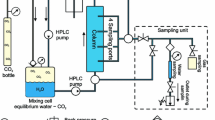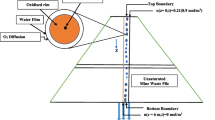Abstract
Pore water concentration profiles of sediments at a site on the Amazon Fan were investigated and simulated with the numerical model CoTReM (column transport and reaction model) to reveal the biogeochemical processes involved. The pore water profiles for gravity core GeoB 4417-7 showed a distinct sulfate–methane transition zone in which deep sulfate reduction occurs. Only a small sulfide peak could be observed at the reaction zone. Due to high amounts of iron minerals, the produced sulfide is instantaneously precipitated in form of iron sulfides. We present a simulation which starts from a steady state system with respect to pore water profiles for methane and sulfate. Furthermore, sulfide, iron, pH, pE, calcium and total inorganic carbon (TIC) were included in the simulation. The program calculated mineral equilibria to mackinawite, iron sulfides (more stable than mackinawite), iron hydroxides and calcite via saturation indices (SI) by a module incorporating the program PHREEQC (Parkhurst 1995). The measured sulfide and iron profiles are obtained in the simulation output by using a constant SI (=0) for mackinawite and calcite, while a depth dependent SI distribution is applied for the PHREEQC phases “Pyrite” and “Fe(OH)3(a)”, representing a composition and the kinetics of different iron sulfides and iron hydroxides. These SI distributions control the results of sulfide and iron pore water profiles, especially conserving the sulfide profile at the reaction zone during the simulation. The results suggest that phases of iron hydroxides are dissolved, mackinawite is precipitated within, and other iron sulfides are precipitated below the reaction zone. The chemical reactivity of iron hydroxides corresponds to the rate of sulfide production. The system H2O–CO2–CaCO3 is generally successfully maintained during the simulation. Deviations to the measured pH profile suggest that further processes are active which are not included in the simulation yet.
Similar content being viewed by others
Author information
Authors and Affiliations
Additional information
Received: 9 November 1998 / Accepted: 26 October 1999
Rights and permissions
About this article
Cite this article
Adler, M., Hensen, C., Kasten, S. et al. Computer simulation of deep sulfate reduction in sediments of the Amazon Fan. Int Journ Earth Sciences 88, 641–654 (2000). https://doi.org/10.1007/s005310050294
Issue Date:
DOI: https://doi.org/10.1007/s005310050294




